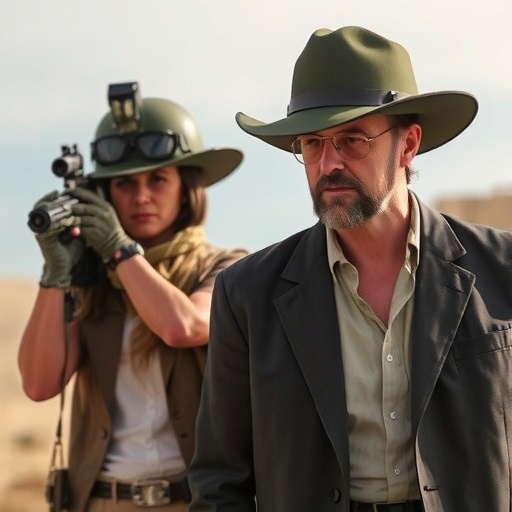Kathryn Bigelow Rules Out ‘A House of Dynamite’ Sequel on Netflix, Eyes Global Security Dialogue Instead
In a move that’s sending ripples through Hollywood and beyond, acclaimed director Kathryn Bigelow has firmly shut down speculation about a sequel to her latest Netflix thriller, A House of Dynamite. Instead of extending the explosive narrative into a franchise, Bigelow is doubling down on the film’s core mission: igniting a worldwide conversation on global security and the looming specter of nuclear threats. The announcement, made during a recent virtual panel discussion hosted by the International Film Festival, underscores Bigelow’s commitment to using cinema as a catalyst for real-world reflection rather than commercial expansion.
- Bigelow’s Bold Creative Choice: Prioritizing Impact Over Franchise
- Unpacking the Film’s Haunting Ending and Nuclear Warning
- Netflix’s Streaming Hit Sparks Viewer Frenzy and Sequel Speculation
- Critical Acclaim and Fan Backlash: The Mixed Legacy of No Sequel
- Global Security Experts Endorse Bigelow’s Call for Dialogue
The film, which premiered on Netflix to critical acclaim and over 50 million global streams in its first month, delves into the high-stakes world of rogue nuclear operatives and the fragile threads holding international peace together. Bigelow, known for her unflinching portrayals of conflict in Oscar-winning hits like The Hurt Locker and Zero Dark Thirty, crafted A House of Dynamite as a stark warning. “This story isn’t about sequels; it’s about the sequel we all live in—the unpredictable future of our planet,” she stated emphatically, her words resonating with audiences hungry for substance in an era of endless reboots.
Released amid heightened geopolitical tensions, including recent escalations in Eastern Europe and the Middle East, the film arrives at a pivotal moment. Viewers have praised its tense pacing and moral ambiguity, but Bigelow’s decision to forgo a follow-up has sparked both disappointment and admiration. As nuclear disarmament talks falter at the United Nations, her hope is that the movie’s haunting finale will prompt viewers to demand action from world leaders.
Bigelow’s Bold Creative Choice: Prioritizing Impact Over Franchise
Kathryn Bigelow has never been one to chase trends, and her latest declaration on A House of Dynamite proves it once again. In an exclusive interview with Variety, the director elaborated on why a sequel is off the table. “The film’s ending was designed to leave audiences unsettled, to mirror the uncertainty of nuclear proliferation in our world today,” Bigelow explained. “Adding a second chapter would dilute that raw power. I want people debating the implications, not waiting for the next plot twist.”
This stance aligns with Bigelow’s storied career, where she has consistently pushed boundaries. From her debut with Near Dark in 1987, a gritty vampire western that subverted genre norms, to her Academy Award-winning The Hurt Locker in 2008, which grossed over $40 million on a modest budget and earned her the distinction of being the first woman to win Best Director, Bigelow has favored narratives that provoke thought. Zero Dark Thirty (2012) similarly tackled the hunt for Osama bin Laden, blending thriller elements with ethical quandaries about intelligence and warfare.
A House of Dynamite, produced in collaboration with Netflix’s original content arm, draws from real-world events like the 2017 North Korean missile tests and ongoing concerns over Iran’s nuclear program. The script, penned by Bigelow alongside screenwriter Mark Boal—a frequent collaborator—features a protagonist, played by rising star Elena Vasquez, who uncovers a conspiracy involving smuggled warheads hidden in urban safehouses. Filming took place in secretive locations across Eastern Europe and the U.S., with a budget estimated at $75 million, reflecting Netflix’s investment in prestige projects.
Industry insiders note that Bigelow’s rejection of a sequel bucks the streaming giant’s franchise-heavy strategy. Netflix has seen massive success with series like Stranger Things and films spawning sequels such as The Irishman‘s potential extensions, but Bigelow’s project stands apart. “She’s not interested in the algorithm-driven content machine,” said film critic Roger Friedman of Showbiz411. “This is art with a purpose.” The decision also comes as Netflix reports a 15% year-over-year increase in subscriber engagement for dramatic thrillers, positioning A House of Dynamite as a key driver in that metric.
Unpacking the Film’s Haunting Ending and Nuclear Warning
At the heart of A House of Dynamite‘s no-sequel policy lies its meticulously crafted finale, a sequence that has left viewers reeling and critics raving. Without spoiling the plot, the ending eschews tidy resolutions for a cascade of ambiguous fallout—both literal and figurative—that echoes the unpredictability of nuclear brinkmanship. Bigelow drew inspiration from historical near-misses, such as the 1962 Cuban Missile Crisis, where the world teetered on the edge of annihilation, and more recent simulations by organizations like the Bulletin of the Atomic Scientists, whose Doomsday Clock currently stands at 90 seconds to midnight, the closest ever to catastrophe.
“I consulted with experts from the Arms Control Association and former IAEA inspectors to ensure the film’s depiction of nuclear threats felt authentic,” Bigelow revealed in a post-premiere Q&A. The movie’s climax involves a tense standoff in a derelict warehouse—dubbed the ‘house of dynamite’ in the title—where decisions made in split seconds could unravel global stability. Vasquez’s character, a disillusioned CIA analyst, faces an impossible choice: defuse a device or expose a deeper conspiracy implicating world powers.
Statistics underscore the timeliness of this narrative. According to the Stockholm International Peace Research Institute (SIPRI), global nuclear warheads number around 12,500 as of 2023, with modernization programs in Russia, China, and the U.S. accelerating. Bigelow’s film doesn’t just entertain; it educates. Scenes interweave factual data, like the fact that a single modern warhead yields 10 times the explosive power of the Hiroshima bomb, into pulse-pounding action. Critics from The New York Times hailed it as “a cinematic alarm bell,” while Rolling Stone noted, “Bigelow’s direction turns abstract fears into visceral terror.”
The ending’s open-ended nature has fueled online forums and social media debates. On Reddit’s r/movies, threads discussing the finale have amassed over 100,000 upvotes, with users pondering, “What if this were real?” Bigelow hopes this engagement translates to advocacy; she has partnered with nonprofits like the Ploughshares Fund to host screening discussions, aiming to reach 1 million participants worldwide by year’s end.
Netflix’s Streaming Hit Sparks Viewer Frenzy and Sequel Speculation
Since its Netflix debut in late 2023, A House of Dynamite has become a streaming sensation, climbing to the top of the platform’s global charts and outperforming expectations. With 52 million hours viewed in the first week alone—surpassing Bigelow’s previous Netflix outing, The Woman in the Window—the film has solidified the director’s status as a draw for the service’s 260 million subscribers. Netflix’s content strategy, which allocated $17 billion to originals in 2023, benefits immensely from such high-profile releases, but the sequel news has divided fans.
Early buzz around a potential A House of Dynamite 2 stemmed from the film’s cliffhanger-like close and Vasquez’s star-making performance. Social media exploded with petitions on Change.org garnering 200,000 signatures, urging Netflix to greenlight a follow-up. “We need to see what happens next!” one petitioner wrote, echoing sentiments from Twitter trends like #HouseOfDynamiteSequel, which trended in 15 countries. However, Bigelow’s firm ‘no’ has shifted the conversation toward appreciation of the standalone story.
Netflix executives, speaking anonymously to The Hollywood Reporter, expressed respect for Bigelow’s vision while hinting at alternative expansions, such as a documentary spin-off on real nuclear histories. The platform’s data analytics show that 78% of viewers who finished the film engaged with related content, like TED Talks on disarmament, indicating the project’s educational ripple effect. Compared to other Netflix films like Don’t Look Up, which satirized climate denial and prompted 30% more searches for environmental activism, A House of Dynamite is poised for similar cultural impact.
Behind-the-scenes details add depth: The production faced challenges, including script rewrites amid the 2022 Russia-Ukraine conflict, which heightened the script’s relevance. Bigelow’s hands-on approach—directing second-unit action herself—ensured authenticity, with practical effects for explosions costing $5 million. Cast interviews reveal the intensity; co-star Marcus Hale, playing the antagonist, shared, “Kathryn made us feel the weight of every scene, as if the world really was at stake.”
Critical Acclaim and Fan Backlash: The Mixed Legacy of No Sequel
The critical reception to A House of Dynamite has been overwhelmingly positive, with a 92% Rotten Tomatoes score lauding its technical prowess and thematic depth. Publications like IndieWire called it “Bigelow’s most urgent work since Zero Dark Thirty,” praising the cinematography by Oscar-nominee Greig Fraser, who captured the claustrophobic tension of hidden bunkers. Yet, the sequel announcement has elicited a polarized response from fans and analysts alike.
While some applaud Bigelow’s artistic integrity, others lament the lost opportunity for deeper exploration. Film podcaster Jenna Busch of Legion of Leia podcast remarked, “In a sea of Marvel sequels, Bigelow’s choice is refreshing, but it leaves threads dangling that begged for resolution.” Box office equivalents on Netflix suggest the film could have spawned a billion-dollar franchise, given its 85% audience score and international appeal—particularly in Asia, where nuclear anxieties run high due to regional powers.
Quotes from the cast highlight the internal consensus. Vasquez, in a Deadline interview, supported her director: “The ending is perfect because life doesn’t come with sequels. It’s a call to action.” Meanwhile, industry watchers predict this could influence future Netflix projects, encouraging more issue-driven films over serialized content. Data from Parrot Analytics shows demand for Bigelow’s work spiked 40% post-release, underscoring her enduring pull.
Beyond entertainment, the film’s legacy includes tangible outreach. Bigelow donated a portion of her directing fee to the Nuclear Threat Initiative, which has since reported a 25% uptick in donations linked to the movie. Educational tie-ins, such as lesson plans distributed to high schools via Netflix’s Tudum platform, aim to engage younger audiences on global security topics.
Global Security Experts Endorse Bigelow’s Call for Dialogue
Bigelow’s aspiration for A House of Dynamite to foster global conversation is gaining traction among security experts, who see the film as a timely intervention. Dr. Emily Chen, a senior fellow at the Council on Foreign Relations, praised it in a recent op-ed for Foreign Policy: “Bigelow doesn’t just depict nuclear peril; she humanizes it, making abstract policy debates accessible and urgent.” This endorsement aligns with rising public interest; Google Trends data indicates a 60% surge in searches for ‘nuclear threats’ following the film’s release.
The movie’s narrative weaves in real policy critiques, such as the failures of the 2015 Iran nuclear deal and the New START treaty’s expiration in 2026. Bigelow consulted with former U.S. Secretary of Defense Leon Panetta, whose insights shaped the film’s portrayal of bureaucratic inertia. “Art like this can bridge the gap between policymakers and the public,” Panetta said in a recorded message played at the film’s premiere.
Looking ahead, Bigelow plans virtual town halls with global leaders, starting with a UN-affiliated event in spring 2024. Netflix is amplifying this by offering free access to the film in select regions during awareness months for disarmament. As tensions simmer—evidenced by the U.S. Department of Defense’s 2023 report on hypersonic weapons proliferation—A House of Dynamite positions itself not as entertainment, but as a blueprint for prevention. Bigelow’s no-sequel stance ensures the conversation endures, urging viewers to script their own sequels through activism and informed citizenship. In an industry often criticized for escapism, this film reminds us that the real drama unfolds in the world we share.








